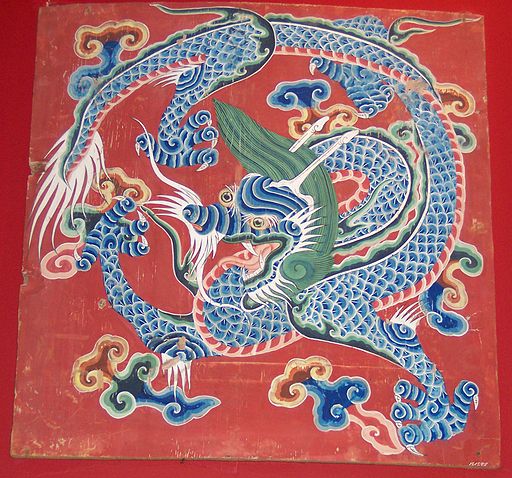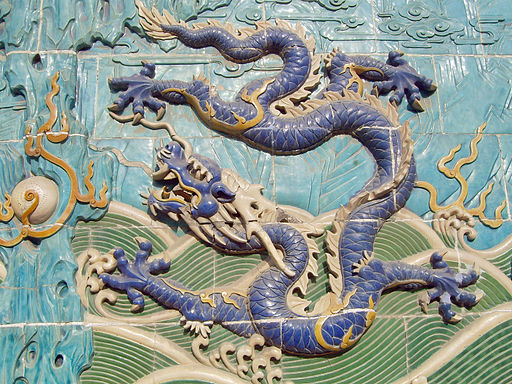2012 - Year of the Water Dragon

 In 2012, Chinese New Year begins on January 23rd and Tibetan New Year (Losar) on February 22nd. Both are celebrated as major Buddhist holidays throughout Asia and within most branches of Buddhism worldwide. In both calendar systems, 2012 is the Year of the Dragon, specifically the Water Dragon.
In 2012, Chinese New Year begins on January 23rd and Tibetan New Year (Losar) on February 22nd. Both are celebrated as major Buddhist holidays throughout Asia and within most branches of Buddhism worldwide. In both calendar systems, 2012 is the Year of the Dragon, specifically the Water Dragon.Although often called 'lunar New Year', the ancient calendars that these holidays are based on are actually 'lunisolar' calendars, because they take both the solar year and moon phase into account. The Lunar New Year typically falls on the second new moon after winter solstice (occasionally the third, in years where a 'leap month' is needed.) This date usually falls somewhere between January 21st and February 20th in the Gregorian Calendar. There are slight differences in the Chinese and Tibetan calculations, so that some years they fall on the same date, but often they are one lunar month apart.
The astrological animal (in 2012, the dragon) and element (in 2012, water) of the year are each figured differently in the zodiac system that both Chinese and Tibetan astrology utilize. The Dragon is associated with power, mysticism, good fortune, unpredictability and non-conformity. Some consider Dragon years to be the most auspicious for having children, as Dragon individuals are usually very charismatic and successful. Water is associated with a gentle power, and is considered a good combination with the dragon � the first time in several years that the Chinese element and animal have been compatible, which many astrologers consider lucky.
Although exact predictions vary, Water Dragon years are generally seen as fortunate, albeit tumultuous, years. It�s a year to initiate big projects and changes, on a personal and social level. Although some will fail, the potential payoff for those that succeed is huge � it is a year of both challenges and breakthroughs. Because the dragon is often associated with unpredictability, Dragon Years often feature surprising or climactic events, which ultimately prove beneficial, although they may cause difficulty in the short term.
 Symbolically, the dragon also has a strong connection to spirituality and enlightenment in both Chinese and Tibetan cultures. In Chinese mythology dragons are one of four 'spiritual animals', along with the phoenix, the unicorn, and the tortoise. Chinese dragons are often depicted chasing a 'wisdom pearl' (see right), symbolic of a closed lotus blossom. The lotus is itself a symbol of enlightenment, with the pearl/closed blossom representing the potential for enlightenment. The dragon swallowing pearls represents the wisdom and merit accumulated on the pathway towards awakening.
Symbolically, the dragon also has a strong connection to spirituality and enlightenment in both Chinese and Tibetan cultures. In Chinese mythology dragons are one of four 'spiritual animals', along with the phoenix, the unicorn, and the tortoise. Chinese dragons are often depicted chasing a 'wisdom pearl' (see right), symbolic of a closed lotus blossom. The lotus is itself a symbol of enlightenment, with the pearl/closed blossom representing the potential for enlightenment. The dragon swallowing pearls represents the wisdom and merit accumulated on the pathway towards awakening. In Tibetan symbology, dragons are one of the 'Four Dignities', along with the snow lion, the tiger, and the garuda (a large mythical bird.) Each represents a different aspect of the Bodhisattva attitude. The dragon represents compassion, or rather the 'sound of compassion', and the powerful clarity that compassion can bring us on the spiritual journey. Through a uniting of power and compassion the dragon represents complete and instant communication and understanding � a knowing that breaks through delusion. The turquoise dragon (shown at the start of this article) is the specific representation of this Dignity.
Because of this symbolic spiritual connection, many people see the Year of the Water Dragon as an especially powerful time for spiritual growth and practice. When combined with the general Dragon qualities of intensity, and the themes of challenges and breakthroughs that characterize Dragon years, 2012 represents the possibility of tremendous spiritual growth, with potential for breaking through to new levels in practice and insight.
You Should Also Read:
2013 - Year of the Female Water Snake
Buddhist Symbols

Editor's Picks Articles
Top Ten Articles
Previous Features
Site Map
Follow @mommymystic
Tweet
Content copyright © 2023 by Lisa Erickson. All rights reserved.
This content was written by Lisa Erickson. If you wish to use this content in any manner, you need written permission. Contact Lisa Erickson for details.


